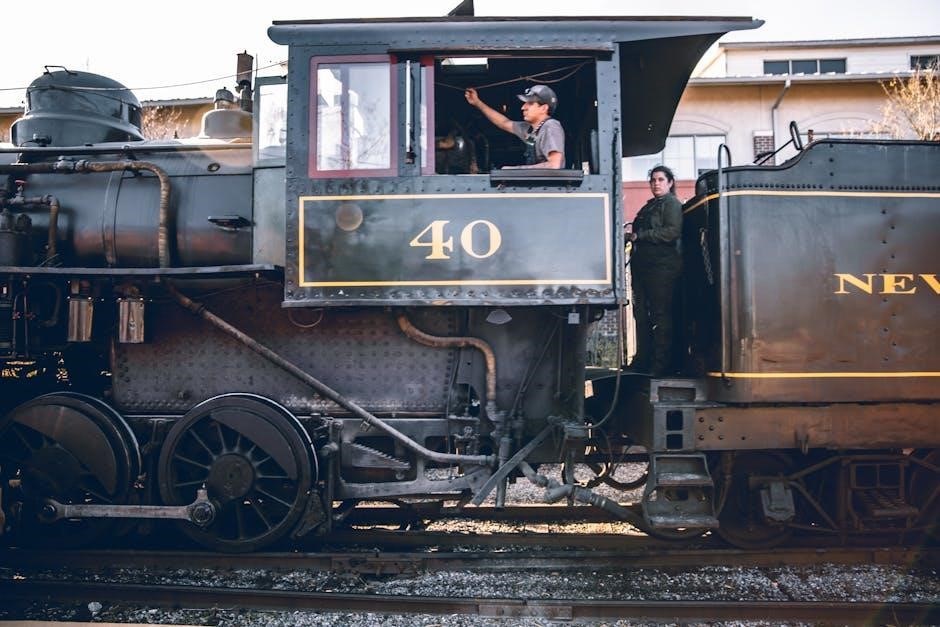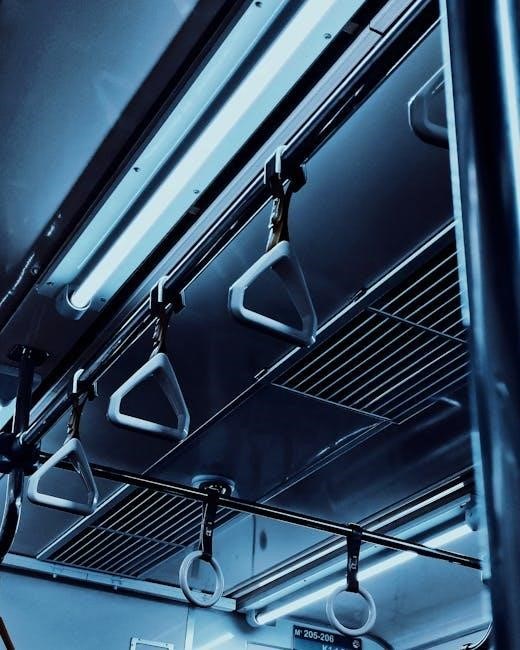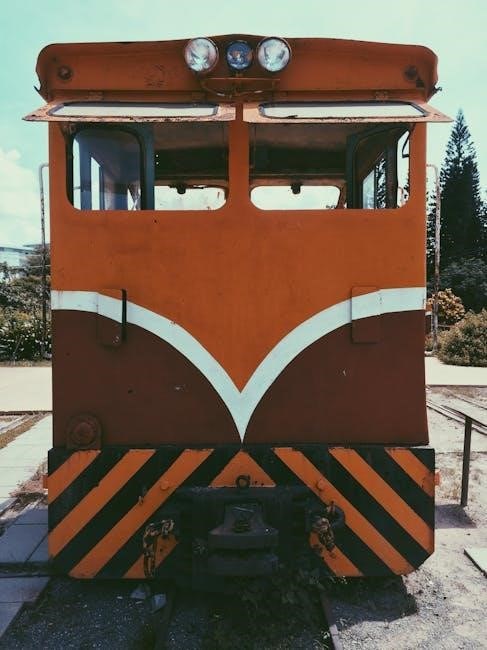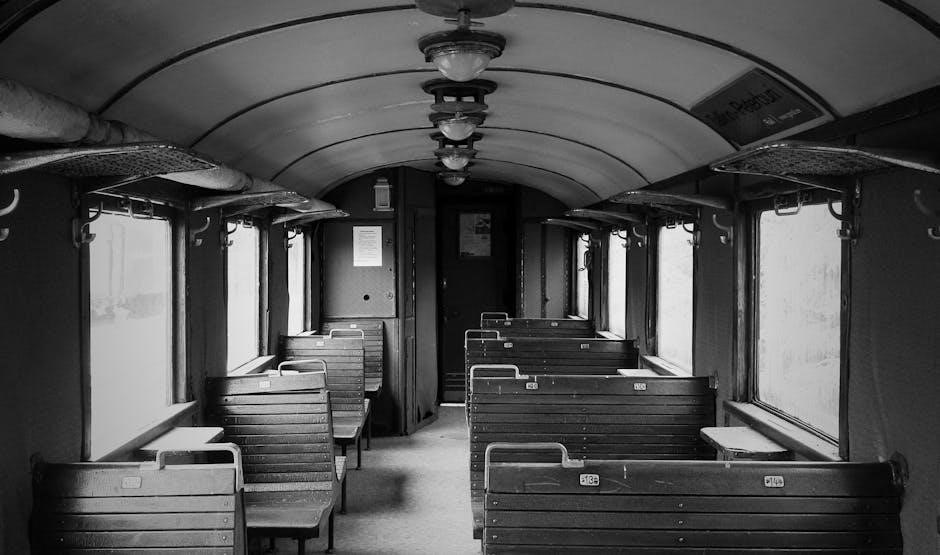Linear guide rails and carriages are essential components in linear motion systems, enabling smooth, precise movement in machinery. They consist of a rail and a carriage with rolling elements like balls or rollers, designed to support heavy loads and ensure accurate positioning in industrial applications.
1.1 Overview of Linear Motion Systems
Linear motion systems are designed to enable movement in a straight line, providing precise control and stability. They typically consist of a guide rail and a carriage equipped with rolling elements like balls or rollers. These systems are widely used in machinery to facilitate smooth, accurate motion, ensuring efficient operation in various industrial and precision applications.
1.2 Importance of Linear Guide Rails and Carriages in Machinery
Linear guide rails and carriages are critical components in machinery, enabling precise and smooth motion while supporting heavy loads. Their ability to maintain accuracy and minimize friction makes them indispensable in various industrial applications, including manufacturing, robotics, and precision equipment. Proper installation and maintenance ensure optimal performance, making them essential for achieving high productivity and reliability in modern machinery systems.

Key Components of Linear Guide Rail Systems
Linear guide rail systems consist of a rail and a carriage, with rolling elements like balls or rollers enabling smooth motion along the rail’s length.
2.1 The Rail: Design and Materials

The rail is the foundation of a linear guide system, typically made from high-strength materials like alloy steel or stainless steel for durability and resistance to wear. Its design incorporates a precision-machined surface to ensure smooth movement. Some rails feature hardened coatings or special treatments to enhance performance in harsh environments. Material selection impacts load capacity, corrosion resistance, and thermal stability, making it critical for specific applications.
2.2 The Carriage: Construction and Functionality
The carriage is a critical component, typically constructed from durable materials like aluminum or steel, ensuring robustness and precision. It houses rolling elements such as ball bearings or rollers, which enable smooth motion along the rail. The carriage’s design minimizes friction and maximizes load capacity, while its sealed construction protects against dust and contaminants, ensuring reliable operation and extended service life in various industrial applications.
Types of Linear Guide Rails
Linear guide rails are categorized into ball-bearing and roller-bearing types, each offering distinct advantages. Ball-bearing guides provide smooth motion and low friction, while roller-bearing guides handle heavier loads and high torque applications, ensuring optimal performance in various industrial scenarios.
3.1 Ball-Bearing Linear Guides
Ball-bearing linear guides utilize recirculating steel balls to enable smooth, low-friction motion along the rail. They are ideal for high-speed applications and provide excellent precision, making them suitable for machinery requiring minimal vibration and noise. Their compact design and high load capacity ensure versatility across various industrial automation and precision equipment needs, delivering reliable performance in demanding environments.
3.2 Roller-Bearing Linear Guides
Roller-bearing linear guides use cylindrical rollers instead of balls, offering higher load capacity and improved torque absorption. They are suitable for heavy-duty applications where stability and rigidity are crucial. Rollers distribute stress more evenly, enhancing durability and resistance to deformation. This makes them ideal for large machinery and industrial setups requiring robust linear motion solutions with minimal deflection under heavy loads.
Selection Criteria for Linear Guide Rails
Selecting linear guide rails involves evaluating load capacity, precision, and environmental compatibility. Factors like required motion accuracy, operating conditions, and system integration are critical for optimal performance and durability.
4.1 Load Capacity and Life Expectancy
Load capacity and life expectancy are critical factors in selecting linear guide rails. The system must handle static and dynamic loads without compromising durability. Life expectancy depends on factors like load, speed, and operating environment. Proper sizing ensures optimal performance and longevity. Always consider these elements to maximize efficiency and minimize downtime in industrial applications.

4.2 Precision and Repeatability Requirements
Precision and repeatability are vital for linear guide systems, ensuring consistent and accurate movement. High-quality rails and carriages minimize deviation, while advanced designs like ball-bearing systems enhance positional accuracy. Repeatability ensures consistent performance over time. Proper installation and maintenance are key to achieving these standards, making them critical for applications requiring high-precision motion control and reliability in industrial automation.

Installation and Alignment of Linear Guide Rails
Proper installation and alignment are crucial for optimal performance. Ensure the rail is securely mounted on a flat surface, and use appropriate tools to maintain accuracy and prevent misalignment.
5.1 Tools and Techniques for Proper Mounting
Proper mounting of linear guide rails requires specific tools and techniques to ensure accuracy and durability. Key tools include precision level tools, clamps, and spacers to align the rail correctly. Tightening screws in a staggered pattern prevents rail deformation. Using a torque wrench ensures correct tension. Following manufacturer guidelines helps achieve optimal performance and longevity of the system.

5.2 Ensuring Parallelism and Accuracy
Ensuring parallelism and accuracy in linear guide rail installation is critical for optimal performance. Use precision level tools to align the rail and carriage system. Spacer blocks or gauge blocks can help maintain consistent spacing. Tightening screws in a staggered pattern ensures even clamping force. Regularly check alignment during and after mounting to prevent misalignment issues. Following manufacturer guidelines ensures precise and reliable operation of the system.
Maintenance and Lubrication
Regular cleaning and lubrication are crucial for extending the life of linear guide rails and carriages. Use high-quality grease to minimize friction and prevent corrosion. Inspect components periodically to address wear or misalignment early, ensuring smooth operation and preventing premature failure;
6.1 Regular Maintenance Tasks
Regular maintenance involves cleaning the rail and carriage to remove dirt and debris, ensuring smooth operation. Lubricate with high-quality grease to reduce friction and wear. Inspect the system for signs of wear or misalignment and address them promptly. Check the condition of the rolling elements and replace them if necessary. Monitor grease levels and reapply as needed to maintain optimal performance and extend lifespan.
6.2 Importance of Proper Lubrication
Proper lubrication is crucial for maintaining the performance and longevity of linear guide rails and carriages. It reduces friction and wear, ensuring smooth motion and preventing overheating. Regular application of high-quality grease prevents corrosion and contamination, protecting the system from premature degradation. Neglecting lubrication can lead to increased wear and potential system failure. Always use recommended lubricants and follow maintenance schedules for optimal performance.

Applications of Linear Guide Rail Systems
Linear guide rail systems are widely used in industrial automation, robotics, CNC machines, and medical equipment. They also find applications in material handling and high-precision engineering.
7.1 Industrial Automation and Robotics
Linear guide rail systems are integral to industrial automation and robotics, enabling precise and smooth motion in CNC machines, robotic arms, and material handling systems. They ensure high repeatability, load capacity, and durability, making them essential for demanding manufacturing environments. Their low friction and stability enhance operational efficiency, supporting continuous production processes and high-precision tasks in automated workflows.
7.2 Medical and Precision Equipment
Linear guide rail systems play a critical role in medical and precision equipment, ensuring smooth, quiet motion in devices like MRI machines, surgical robots, and laboratory instruments. Their high precision and stability are essential for delicate procedures, while their low friction and durability support reliable operation in demanding environments, maintaining accuracy and patient safety in sensitive applications.
Linear guide rails often face issues like misalignment, noise, and wear. Troubleshooting involves checking alignment, inspecting for debris, and ensuring proper lubrication. Regular maintenance and timely part replacements are crucial for optimal performance and longevity.
Troubleshooting Common Issues
8.1 Identifying and Addressing Misalignment
Misalignment is a common issue in linear guide systems, causing uneven wear and reduced performance. To address this, inspect the rail and carriage for proper parallelism. Use shims or adjust mounting brackets to correct alignment. Ensure all bolts are tightened evenly and check for any debris obstructing smooth movement. Regular checks prevent premature wear and system failure.

8.2 Dealing with Noise and Vibration
Noise and vibration in linear guide systems often result from improper installation, debris, or lack of lubrication. Inspect the rail and carriage for cleanliness and alignment. Apply suitable lubricants to reduce friction and dampen movement. Consider using vibration-dampening mounts or isolators to minimize operational disturbances. Addressing these issues ensures smoother operation, extends component lifespan, and maintains overall system efficiency and performance over time.

Advanced Features and Innovations
Modern linear guide systems feature anti-corrosion coatings, integrated sensors, and smart technology for real-time monitoring, enhancing durability and efficiency in demanding environments.
9.1 Anti-Corrosion and Dust-Resistant Designs
Advanced linear guide systems now feature anti-corrosion coatings and dust-resistant seals, ensuring longevity in harsh environments. Stainless steel and alloy materials are often used to enhance durability. These designs minimize maintenance and prevent contamination, making them ideal for industrial and outdoor applications where exposure to moisture and particles is prevalent.
9.2 Integrated Sensors and Smart Features
Modern linear guide systems incorporate integrated sensors and smart features for real-time monitoring. These innovations enable precise positioning, temperature monitoring, and predictive maintenance. Sensors detect wear and tear, while smart features optimize performance by adjusting speeds and loads automatically, enhancing efficiency and reducing operational downtime in advanced machinery and automation systems.
Cost Considerations and Budgeting
When selecting linear guide rails, balancing quality and cost is crucial. Budgeting involves evaluating initial investment, long-term maintenance, and potential upgrades to ensure cost efficiency and performance.
10.1 Balancing Quality and Cost
Balancing quality and cost requires evaluating the application’s demands. High-quality linear guide rails may have a higher upfront cost but offer durability and precision, reducing long-term maintenance expenses. Conversely, cheaper options might compromise on performance and lifespan, leading to increased costs over time. Budgeting should focus on both initial investment and future operational efficiency.
10.2 Long-Term Cost Efficiency
Long-term cost efficiency is achieved by selecting durable, high-performance linear guide rails and carriages. While initial costs may be higher, superior materials and construction reduce maintenance and replacement needs. Energy-efficient designs also lower operational costs over time, making the investment justified for applications requiring sustained reliability and performance.

Environmental and Operational Constraints
Environmental and operational constraints require linear guide rails to withstand harsh conditions, including humidity, temperature fluctuations, and dust. High-speed and high-temperature applications demand specialized materials and coatings.
11.1 Operating in Harsh Environments
Linear guide rails must often operate in harsh environments, including high humidity, extreme temperatures, and exposure to dust or chemicals. Anti-corrosion coatings and sealed carriages are essential to protect against contamination and ensure reliable performance. In heavy-duty applications, such as construction or agriculture, durable materials and robust designs are critical to withstand rough conditions and maintain operational efficiency over time.
11.2 High-Temperature and High-Speed Applications
In high-temperature and high-speed environments, linear guide rails and carriages must withstand thermal expansion and friction-induced heat. Specialized materials, such as heat-resistant alloys, and advanced lubrication systems are used to maintain stability and reduce wear. For high-speed applications, low-mass designs and vibration-damping features ensure smooth operation and extended service life, even in demanding industrial and automotive settings.
12.1 Summary of Key Considerations
When selecting linear guide rails and carriages, prioritize load capacity, precision, and durability. Proper lubrication and installation techniques are crucial for optimal performance. Consider material quality and environmental factors to ensure longevity. Regular maintenance and alignment checks are essential for sustained accuracy. Balancing cost and quality ensures long-term efficiency and reliability in industrial applications.
12.2 Emerging Trends in Linear Motion Technology
Advancements in linear motion technology include integrated sensors for real-time monitoring and smart features enabling IoT connectivity. Anti-corrosion and dust-resistant designs are gaining traction for harsh environments. High-speed applications with minimal vibration are being prioritized, alongside lightweight yet durable materials. These innovations enhance efficiency, precision, and adaptability, driving progress in automation, robotics, and precision machinery industries.



0 Comments